Ahimsa: Being Nice is Not Enough
This article originally appeared on Yoga Journal
Ahimsa, non-harming, is probably the most talked about of the yamas, the moral disciplines outlined in Patanjali's Yoga Sutras. It's the first one on the list and, frankly, seems like an easy one to accomplish: don't hurt people. Simple enough, since most of us don't wake up each morning and "choose violence." If we are reasonably nice to people around us, we can tell ourselves that we have ahimsa down. But if you look closely, there are nuances to ahimsa that extend beyond a simple translation of the word.
For one thing, ahimsa involves more than being nice. Nice is being agreeable and pleasant. Non-harming lives more in the realm of kindness-a spirit of generosity, being considerate, or having compassion. Nice is a smile emoji at the end of a text. Kindness is taking someone’s hands and smiling into their eyes.
Can you be nice and kind?
The two are not mutually exclusive; you can be nice and kind. But "not every action coming from a place of benevolence has a pleasing effect," according to Kelly Shi, a philosophy scholar and former Hackworth Fellow and the Markkula Center for Applied Ethics at Santa Clara University. It may not feel "nice" to break bad news to a friend, for example. But it can be an act of kindness that saves the person from hurt or harm in the long term.
Nice lives in the realm of obligations and etiquette, social norms and expectations. But politeness can hide a multitude of feelings that are anything but nice. And we can do nice things that have nothing to do with what's in our hearts. For ahimsa-non harming-to be true, it must come from a place of deep, thoughtful compassion. We practice all eight limbs of yoga to equip ourselves to plumb that depth.
Ultimately, the principle of ahimsa can be applied to all kinds of decisions that impact our lives--whether to eat meat, to who to vote for, or to how to address the criminal justice system. But before you can make those decisions, you have to cultivate a spirit of non-harming within yourself--and in everything you do. Your asana practice can be a step toward cultivating an energy of non-harming, especially if you apply the principle to how you approach your yoga poses.
Inspiration for Ahimsa
With this sequence, we invite you to leave behind any tendency to force yourself into a pose, power through pain, judge your abilities, or otherwise be unkind to yourself. Instead, practice in a way that is nourishing to body, mind, and soul. As you practice the poses, consider what you truly need and generously offer it to yourself. Be gentle with your approach. And let this sequence inspire you.
Hold the poses for 3 or more deep breaths and pay attention to how your body feels in each before you move to the next pose. Kindness to yourself includes taking any variation or modification that you need. Breathe and meditate on the concept of ahimsa.
Ahimsa Practice
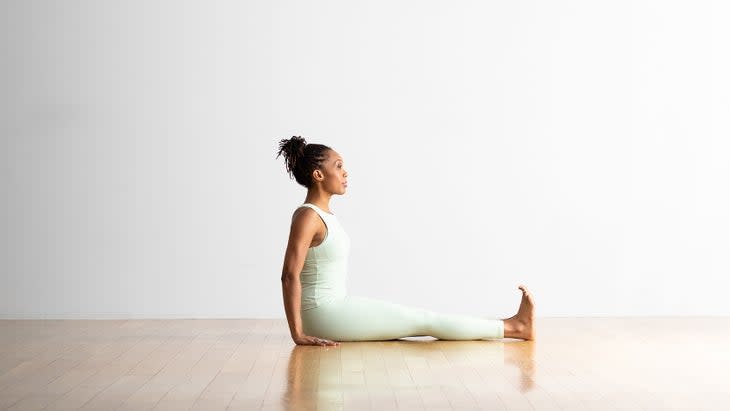
Dandasana (Staff Pose)
Sit with your legs extended straight in front of you. Touch your big toes together and keep a small amount of space between your heels. Press your big-toe mounds forward and draw your toes back toward your body.
Bring your hands to rest alongside your hips and allow your shoulders to relax down away from your ears. Broaden across your collarbones, draw your upper arms back, and lift your sternum.
Reach the crown of your head toward the ceiling and lengthen your back without taking too rigid a position. Stay in this pose for several breaths, finding a balance between ease and strength.
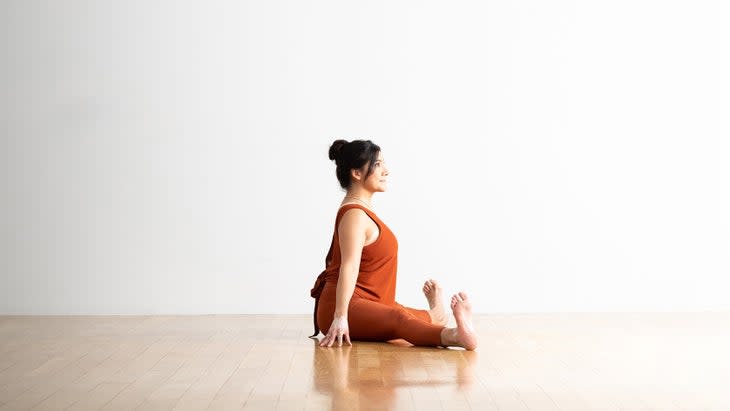
Upavistha Konasana (Wide-Angled Seated Forward Bend)
From Dandasana, open your legs out to the sides. Move your feet apart, just until you feel a gentle stretch in your groin. Flex your feet and engage your thighs so that the tops of your thighs, your knees, and your toes are pointing up.
Inhale and lengthen your spine; exhale and hinge at your hips bringing your upper body forward any amount. You may choose to walk your hands forward to bring your torso toward the floor between your legs. Keep your back straight, but give yourself permission to move in any way your body needs. You may choose to explore folding over one leg and then the other.
To exit the pose, walk your hands back toward your body and bring your legs together to return to Staff Pose. Then swing both legs around in either direction to bring yourself to your knees in Tabletop.
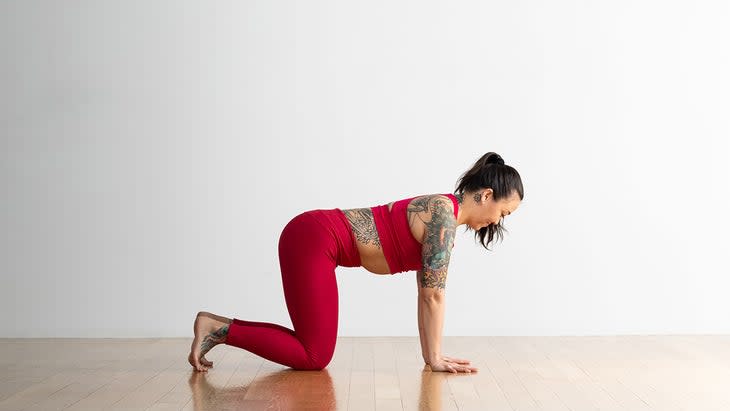
Table Top Pose
Come to your hands and knees, with your legs hip-width apart and your knees under your hips. Align your shoulders, elbows, and wrists. Spread your fingers wide and press your fingertips into the floor.
Engage and lift your belly toward your spine. Lengthen your back, reaching the crown of your head forward. Look straight down.
Take the opportunity to bend and flex your spine. Shift your hips and upper body to curve the spine left and right, practice Cat and Cow pose, or find organic movement that encourages flexibility. When you are ready, press back into Child's Pose.
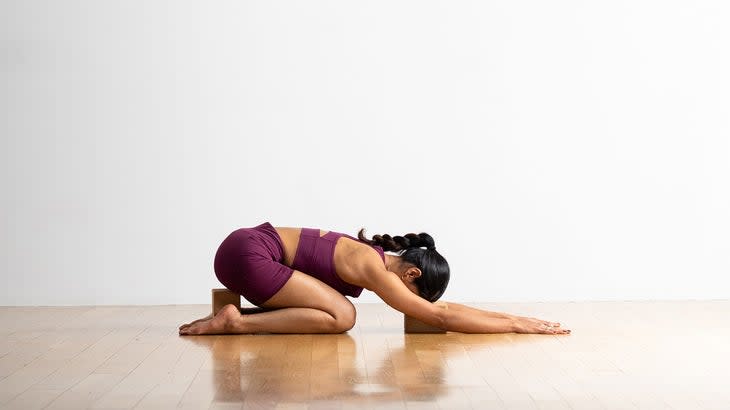
Balasana (Child's Pose)
Kneel on the floor. Touch your big toes together and sit on your heels, a block, or a blanket roll placed under your hips. Separate your knees about as wide as your hips. If your body calls for more of a massage along the front of the body, keep your knees closer together.
Exhale and fold forward; lay your torso down between your thighs. Nestle your hip points down onto the inner thighs. Broaden across the back of your pelvis at the sacrum and lengthen your tailbone away from the back. Tuck your chin slightly. Use a block under your forehead if that is more comfortable.
Walk your hands out toward the front of your mat for Extended Child's pose. Or reach back toward your feet and rest the arms on the floor alongside your torso, palms up, releasing the fronts of your shoulders toward the floor to feel a widening across your back.
When you are ready, walk your hands back toward your body and press up into Table.
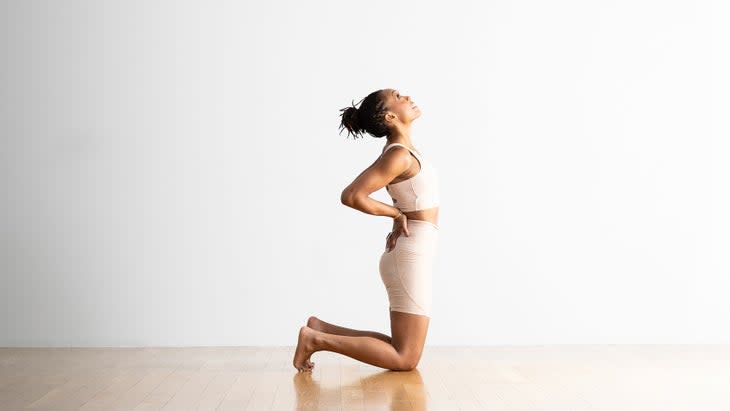
Ustrasana (Camel Pose)
From Table Pose, press away from the floor to stand on your knees with your legs hip-width apart. Keep your hips over your knees and squeeze your thighs toward each other. Tuck your toes or put the tops of your feet on the floor.
Engage your lower belly. Reach your tailbone toward your knees, lift your sternum, and reach the crown of your head up to create length in your spine. Keep your chin slightly tucked.
Place your hands on your hips or on behind you with your palms at the top of your buttocks and your fingers pointing down. Draw your shoulders and elbows back to feel an opening in the front of your body.
On an exhale, gently arch your back into a slight back bend, pressing your hip points forward.
To exit, bring your chin to your chest, engage your lower belly and use your hands to support your lower back as you come slowly back up to your knees.
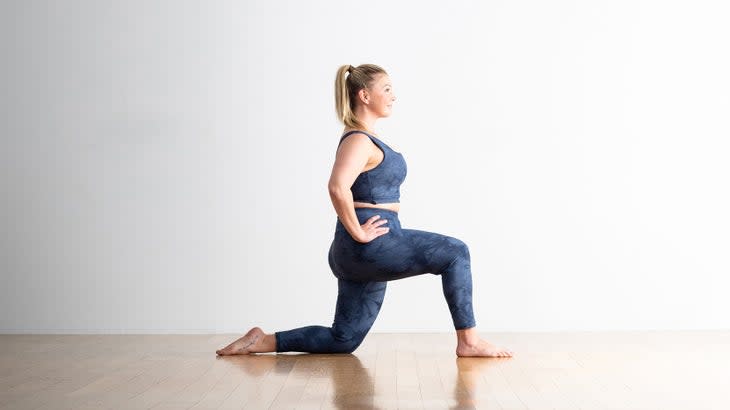
Anjaneyasana (Low Lunge)
From Ustrasana, step your right foot forward so that your right leg forms a right angle.
Place your hands on your hips or fold them together on your right thigh, and make sure both hips are facing forward equally.
If you want more of a stretch, inch your right foot forward or slide your left foot back until you feel a comfortable stretch in the left front thigh and groin.
Allow your shoulders to relax away from your ears, widen your collar bone, and press the tops of your shoulders back. Look forward or arch back slightly, opening your chest.
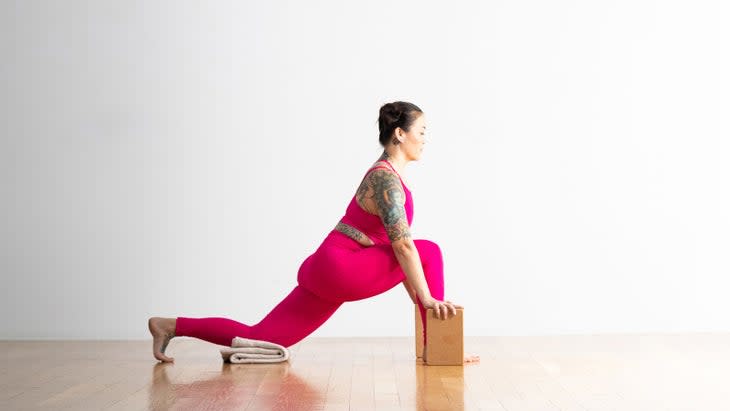
Banarasana (High Lunge) variation
From Lunge, hinge at your hips to fold forward and place your hands on the floor or on blocks on each side of your right foot. Keep your right knee over your ankle.
Extend your left leg back to create more stretch along the front or your thigh. When you feel steady, you may lift your left knee off the floor and straighten your back leg, pressing your heel away from your body. Feel a comfortable stretch in the left front thigh and groin.
Keep the back of your neck long, extending the crown of your head forward as you gaze toward the floor
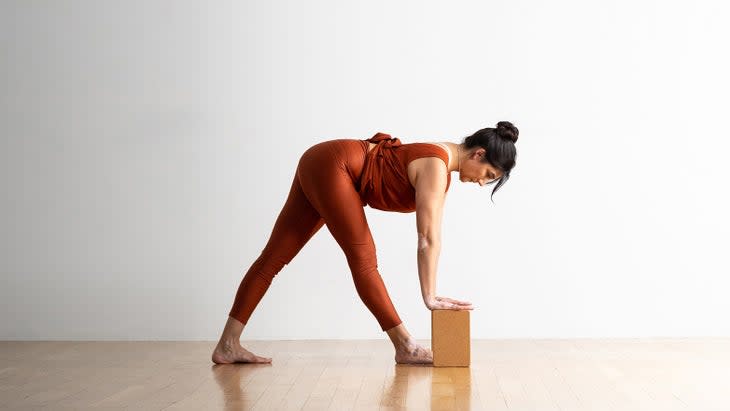
Parsvottanasana (Pyramid Pose/Intense Side Stretch Pose)
From Lunge, lift your back knee off the mat, straighten your front leg, and lift your hips up toward the ceiling.
Engage your abdomen, maintain a hinge at your hips, and fold forward. Keep your hips facing forward equally. Allow the crown of your head to reach toward your right foot.
Find a balance between stretch and movement in the pose. You can play with lifting the right toes to stretch your feet and calf. Come up on your back toes to engage your left thigh and calf. Slightly bend either leg (or both) to explore the stretch.
When you are ready, step your left foot forward to meet your right in Uttanasana.
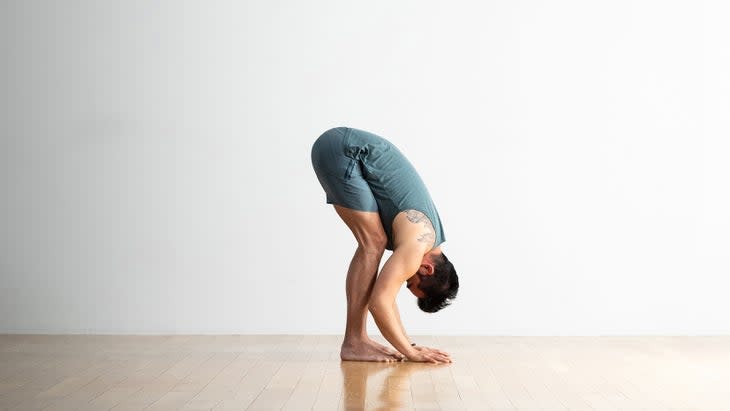
Uttanasana (Standing Forward Bend)
Bend your knees slightly, hinge from your hips and fold your torso over your legs. Keep your legs slightly bent or lift your kneecaps and gently press both legs toward straight without hyperextending.
Keep your hands on the floor in front of you or grasp each elbow with the opposite hand and allow your torso and the crown of your head to extend down toward the floor.
When you are ready, bend your knees deeply and lower into a seated position.
Repeat steps 5-9 on the opposite side.

Savasana (Corpse Pose)
Finish the sequence by resting in Savasana. Lie on the floor and extend your legs with your feet apart and toes turned out. Release your arms to the floor, angled evenly away from the sides of the body with your palms up. Move your shoulders down and away from your ears, and allow them to relax back toward the floor. Slightly tuck your chin to create length in the back of your neck. If it's more comfortable, support your head and neck with a folded blanket, or roll a blanket under your knees. Soften your face; close your eyes. Stay in this pose for at least 5 minutes and continue to rest as long as you like. To exit, exhale and gently roll onto one side. Take 2 or 3 breaths. With another exhale, press your hands against the floor and lift your torso, bringing your head slowly after.
For more about the yama ahimsa, see Rina Deshpande's article What is Ahimsa?
Tamara Jeffries, RYT-200, is a Senior Editor at Yoga Journal. She has been teaching yoga since 2013 and practicing for more than two decades.
For exclusive access to all of our fitness, gear, adventure, and travel stories, plus discounts on trips, events, and gear, sign up for Outside+ today.

